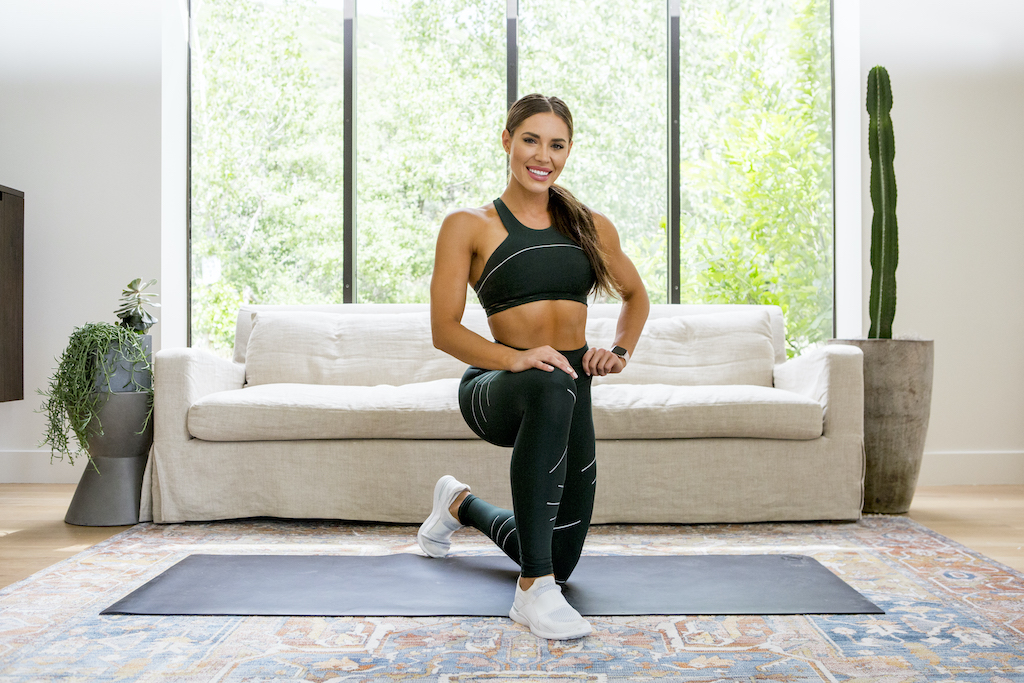Low-Impact Exercise Substitutions For PWR at Home


I’ve had so many requests from the PWR community have requested low-impact exercise options for my PWR at Home programming — so here are some to get you started.
Before going any further, I want you to know that low-impact exercises aren’t necessarily easier — you will still get your heart rate up! The advantage of a low-impact workout is that you’ll put less strain on your joints.
Low impact exercises for high-intensity workouts
I love doing plyometric exercises to get my heart rate up, and that’s why there are jumping exercises in both of my PWR programs. However, if you have sore knees, or you’ve done a number of tough training sessions already that week, you might prefer a low-impact alternative that still gets your working hard.
To help you to slay your PWR or PWR at Home workouts when you want to be a little gentler to your body, try substituting your PWR exercises for these lower-impact alternatives.
Double-pulse squat instead of jump squat
Jump squats are a high-impact exercise that gets your heart rate up and recruits the fast-twitch muscle fibres in your legs to improve your muscle power and response time. However, sometimes you need a break from high-impact exercises such as this one.
You can replace jump squats with double-pulse squats. I recommend focusing on your form to ensure you are recruiting your glutes correctly.
Here’s how to do a double-pulse squat:
- Plant both feet on the floor shoulder-width apart. This is your starting position.
- Inhale. Looking straight ahead, bend at both the hips and knees, ensuring that your knees remain in line with your toes. Continue bending your knees until your upper legs are parallel with the floor. Ensure that your back remains between a 45- to 90-degree angle to your hips. This is called full squat position.
- Push through your heels and extend your legs slightly. Bend your knees to return to full squat position.
- Exhale. Push through your heels and extend your legs to return to the starting position.
- Repeat.
Use these cues to ensure that you execute the movement with proper form for every repetition:
- Keep your core strong
- Knees should be aligned with your toes
- Shoulders back
- It’s not about how low you go, it’s about doing the movement with correct form!
High knees become reverse lunge to knee-up
High knees are a great exercise to get your heart rate up, but sometimes you might want or need a low-impact alternative to protect your ankles and knees.
Next time you see high-knees in your workout plan, try substituting with a reverse lunge and knee-up, instead. This exercise will build strength in your legs and hips.
Here’s how to do it:
- Plant both feet on the floor shoulder-width apart. This is your starting position.
- Inhale. Carefully take a big step backwards with your right foot. As you plant your foot on the floor, bend both knees to approximately 90 degrees, ensuring that your weight is evenly distributed between both legs. If done correctly, your front knee should be aligned with your ankle and your back knee should be hovering just off the floor.
- Exhale. Extend both knees and transfer your weight onto your left foot. At the same time, elevate your right foot to bring your knee into your chest.
- Complete an equal number of repetitions on each side.
Jump lunges become static lunges
Jump lunges are a dynamic exercise that might not be suitable if you are sore from your last leg workout or if you are unable to do high-impact moves. That shouldn’t stop you from exercising — just sub out the exercise with static lunges.
This unilateral exercise will help to correct any imbalances between left and right, creating stability for your future workouts.
To get the best results, I want you to really focus on your form throughout the whole movement.
Here’s how to do static lunges:
- Plant both feet on the floor in a split stance with your left leg forward and your right leg back, ensuring that your feet are shoulder-width apart. This is your starting position.
- Inhale. Bend both knees to approximately 90 degrees. If done correctly, your front knee should be aligned with your ankle and your back knee should be hovering just off the floor.
- Exhale. Extend both knees to return to the starting position.
- Complete an equal number of repetitions on each side.
Burpee becomes low-impact burpee
It might surprise you that even burpees can be made into a low-impact exercise! Simply slow the movement down and lower the impact by stepping instead of jumping.
If you want to make a low-impact burpee more intense, try adding dumbbells or kettlebells to the movement, like I have in this demonstration.
Here’s how to do it:
- Holding one dumbbell in each hand, plant both feet on the floor slightly further than shoulder width apart. Looking straight ahead, bend at both the hips and knees, and place the dumbbells on the floor directly in front of your feet.
- Holding on to the dumbbells, kick both of your feet backwards so that your legs are completely extended behind you, resting on the balls of your feet. Your body should be in one straight line from head to toe.
- Jump both of your feet in towards the dumbbells, ensuring that your feet remain shoulder width apart.
- At the same time, push through your heels to extend your legs and bend your elbows to bring both dumbbells into your chest.
Ensure that the heads of the dumbbells are facing forwards, as shown.
- Extend your arms and press both dumbbells up above your head.
- Gently lower the dumbbells by firstly bringing them into your chest and then extending your arms downwards and bringing them down by your sides. Repeat.
You can use these low-impact exercises to substitute out any of the moves in PWR or PWR at Home, or you can combine them to get a quick express workout, like the one I demonstrate below.
Low-impact HIIT workout from my Instagram
Here’s an example of a low-impact PWR HIIT session that puts all these exercises together. Try it for yourself to get your heart pumping!
Low-impact workouts can help you to build strength and fitness
Not every workout has to be a high-impact workout! I like to mix up my PWR workouts with a variety of high-intensity, high-impact moves alongside lower-impact days — the key is listening to your body to ensure that the exercise you choose on that day will nourish you.
You can use the above exercises to modify your workouts, or create your own quick workout. I hope you enjoy it!
Kels
Xx
* Disclaimer: This blog post is not intended to replace the advice of a medical professional. The above information should not be used to diagnose, treat, or prevent any disease or medical condition. Please consult your doctor before making any changes to your diet, sleep methods, daily activity, or fitness routine. Sweat assumes no responsibility for any personal injury or damage sustained by any recommendations, opinions, or advice given in this article.




<#= c.user.username #><#= moment(c.created_at * 1000).fromNow() #>
<#= c.html_body #> <# if (c.images) { #>
<# } #>